Monthly Summaries
Issue 28, April 2019
[DOI]
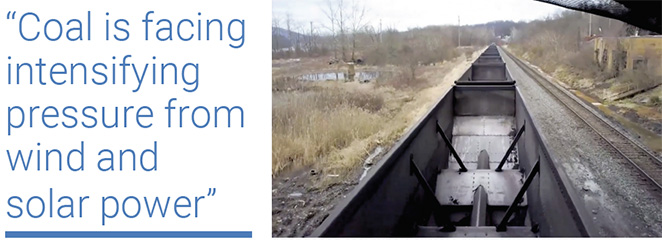
Abandoned coal mine in the US. Source: CNN.
-
Globally, the quantity of coverage remained steady as compared with the previous month of March 2019. However, coverage in April 2019 went up nearly 50% compared to coverage globally in April 2018.
-
Across the seven regions we monitor (Asia, Africa, Europe, Latin America, Middle East, North America, Oceania), Europe saw the largest rise in coverage, increasing nearly 12% from the previous month and up 89% from European coverage a year earlier (April 2018).
-
Within Europe, United Kingdom media coverage increased remarkably, up 39% from the previous month of March, and also up 167% from April 2018: cultural and political movements and pressures drove coverage, notably through Extinction Rebellion protests and Greta Thunberg actions (see below for more).
April media attention to climate change and global warming continued to be driven by political economic, ecological/meteorological, scientific and cultural themes.
Figure 1 shows increases and decreases in newspaper media coverage at the global scale – organized into seven geographical regions around the world – from January 2004 through April 2019.
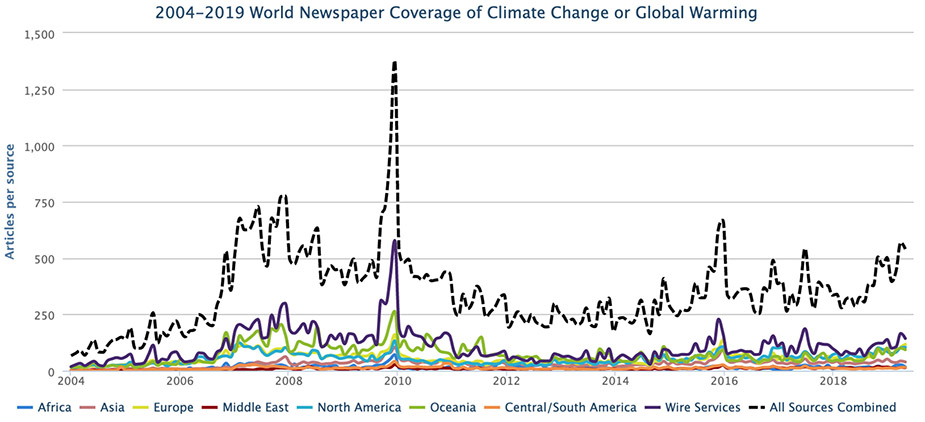
Figure 1. Newspaper media coverage of climate change or global warming in seventy-four sources across forty countries in seven different regions around the world, from January 2004 through April 2019.
This month we have added eight new European sources to our counts. These are Correio da Manhã (Portugal), La Republica (Italy), Corriere della Sera (Italy), Le Monde (France), Le Figaro (France), El Mundo (Spain), La Vanguardia (Spain) and Expansión (Spain). These new sources, along with previous monitoring in Europe enable us to now provide a regional tracking of 19 sources (see Figure 2). Overall, these new sources expand our monitoring to three new countries (Italy, France, Portugal) and two new languages (Italian and French). In Italian we search the terms ‘cambiamenti climatici’ and ‘riscaldamento globale’, in French we search ‘changement climatique’ and ‘réchauffement climatique’.
Therefore, we at MeCCO now track media coverage of climate change or global warming across 89 sources (newspapers, TV and radio) in 41 countries and 7 languages (English, French, German, Italian, Japanese, Portuguese, Spanish).
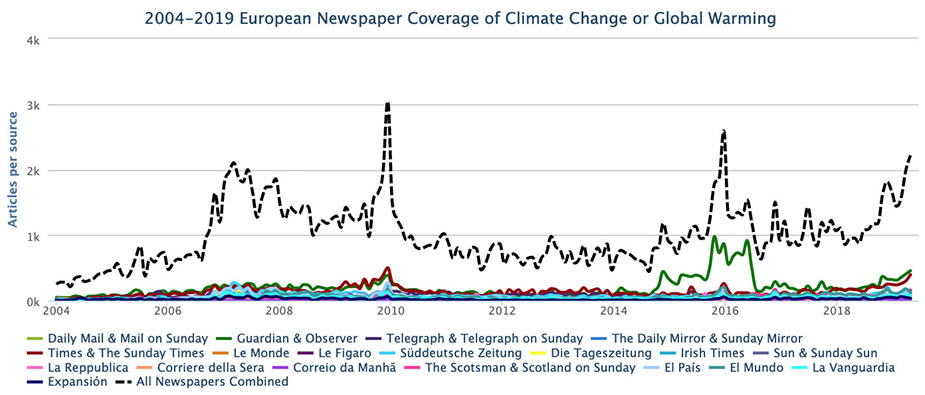
Figure 2. Newspaper media coverage of climate change or global warming in 19 sources across Europe from January 2004 through April 2019.
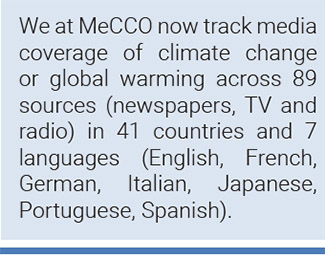 Considering thematic dimensions of coverage in April, political and economic content punctuated media coverage throughout the month. For instance, in the United States (US), discussions of federal (in)action on climate change continued. For example, mid-month an Environmental Protection Agency ‘Planning for Natural Disaster Debris’ guide with mentions of climate change adaptation warranted coverage. Washington Post journalists Juliet Eilperin and Brady Dennis wrote, “The Environmental Protection Agency published a 150-page document this past week with a straightforward message for coping with the fallout from natural disasters across the country: Start planning for the fact that climate change is going to make these catastrophes worse. The language, included in guidance on how to address the debris left in the wake of floods, hurricanes and wildfires, is at odds with the rhetoric of the EPA’s own leader, Andrew Wheeler”.
Considering thematic dimensions of coverage in April, political and economic content punctuated media coverage throughout the month. For instance, in the United States (US), discussions of federal (in)action on climate change continued. For example, mid-month an Environmental Protection Agency ‘Planning for Natural Disaster Debris’ guide with mentions of climate change adaptation warranted coverage. Washington Post journalists Juliet Eilperin and Brady Dennis wrote, “The Environmental Protection Agency published a 150-page document this past week with a straightforward message for coping with the fallout from natural disasters across the country: Start planning for the fact that climate change is going to make these catastrophes worse. The language, included in guidance on how to address the debris left in the wake of floods, hurricanes and wildfires, is at odds with the rhetoric of the EPA’s own leader, Andrew Wheeler”.
Also in April, US Presidential candidates vying for the Democratic nomination have increasingly discussed their stances on climate change. These stances and platforms have garnered discernible media interest. For example, 2020 hopeful Beto O’Rourke’s $5 trillion plan to combat climate change attracted attention. CNN journalists Kate Sullivan and Leyla Santiago reported “former Texas Democratic congressman's plan called climate change "the greatest threat we face" and outlined a four-part framework to address this "existential threat" and "growing emergency ... O'Rourke's ambitious, first major policy rollout comes amid questions from voters and critics about how he would take on key issues should he be elected president”. Meanwhile, Kathleen Ronayne and Will Weissert – covering Beto O’Rourke’s announcement for the Associated Press and PBS Newshour - noted it “calls on the U.S. to guarantee net-zero carbon emissions by 2050, while promising to reach half that goal in just the next 11 years”.
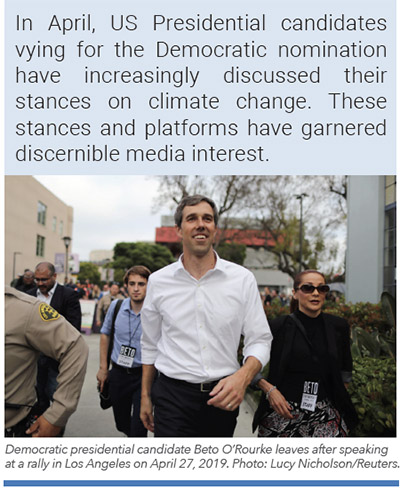 And late in April, a report from the Institute for Energy Economics and Financial Analysis regarding the ongoing political economy of coal vis-à-vis renewable energy generation contributed to coverage of climate change. For example, CNN journalist Matt Egan wrote, “The renewable energy sector is projected to generate more electricity than coal during the month of April, according to a recent report published by the Institute for Energy Economics and Financial Analysis (IEEFA). That's never happened before. Coal, long the king of the power sector, has already been dethroned by natural gas, a much cleaner burning fossil fuel. Now, coal is facing intensifying pressure from wind and solar power” Egan quoted Dennis Wamstead from IEEFA who commented, “Five years ago this never would have been close to happening…The transition that's going on in the electric sector in the United States has been phenomenal”.
And late in April, a report from the Institute for Energy Economics and Financial Analysis regarding the ongoing political economy of coal vis-à-vis renewable energy generation contributed to coverage of climate change. For example, CNN journalist Matt Egan wrote, “The renewable energy sector is projected to generate more electricity than coal during the month of April, according to a recent report published by the Institute for Energy Economics and Financial Analysis (IEEFA). That's never happened before. Coal, long the king of the power sector, has already been dethroned by natural gas, a much cleaner burning fossil fuel. Now, coal is facing intensifying pressure from wind and solar power” Egan quoted Dennis Wamstead from IEEFA who commented, “Five years ago this never would have been close to happening…The transition that's going on in the electric sector in the United States has been phenomenal”.
Across the globe in April, many news stories focused on the cultural arena. For example, in mid-April Amazon employees penned an open letter to CEO Jeff Bezos, stating discontent with the company’s stance on sustainability and climate change. Signed by approximately 4,500 workers, this disturbance in business cultures generated media attention. Journalist Karen Weise from The New York Times reported, “Employees at big tech companies have pushed back against their employers for working with the military and law enforcement offices, and demanded better treatment of women and minorities. Now, thousands of them are also taking on climate change. This week, more than 4,200 Amazon employees called on the company to rethink how it addresses and contributes to a warming planet. The action is the largest employee-driven movement on climate change to take place in the influential tech industry. The workers say the company needs to make firm commitments to reduce its carbon footprint across its vast operations, not make piecemeal or vague announcements. And they say that Amazon should stop offering custom cloud-computing services that help the oil and gas industry find and extract more fossil fuels”. Meanwhile, reporter Joseph Pisani from the Associated Press noted, “The online shopping giant, which already works with BP and Shell, has been trying to woo more oil and gas companies to use its technology to help them find drillable oil faster, angering workers who have been pushing Amazon to do more to combat climate change”.
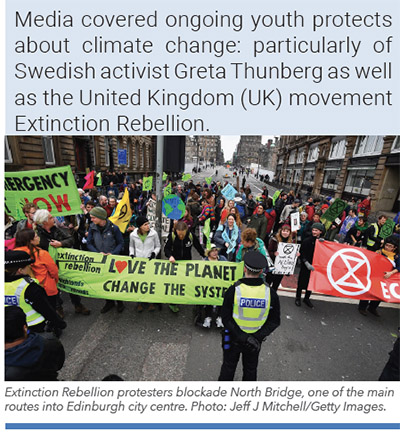 Also, media covered ongoing youth protects about climate change: particularly of Swedish activist Greta Thunberg as well as the United Kingdom (UK) movement Extinction Rebellion. For example, from US National Public Radio, David Greene and Frank Langfitt discussed how Extinction Rebellion disrupted ‘business as usual’ in London on April 17. Greene noted, “protesters have blocked traffic in parts of the city for several days now to put pressure on the British government to address climate change. Demonstrators have shut down 55 bus routes and, according to police, affected half a million people. Police have already made nearly 300 arrests”. Meanwhile, Guardian journalists Matthew Taylor, Damien Gayle and Libby Brooks observed, “Thousands of people have taken part in the civil disobedience protests since Monday, blockading four landmarks in the capital in an attempt to force the government to take action on the escalating climate crisis…the four sites – Marble Arch, Waterloo Bridge, Parliament Square and Oxford Circus – remained under the control of protesters, causing delays and diversions in the surrounding areas”. Also in The Guardian a few days later,journalists Vikram Dodd , Damien Gayle and Martha Busby wrote, “Governments will no longer be able ignore the impending climate and ecological crisis, Greta Thunberg, the teenage climate activist, has told Extinction Rebellion protesters gathered at Marble Arch in London. In a speech on Sunday night where she took aim at politicians who have for too long been able to satisfy demands for action with “beautiful words and promises”, the Swedish 16-year-old said humanity was sitting at a crossroads, but that those gathered had chosen which path they wish to take”.
Also, media covered ongoing youth protects about climate change: particularly of Swedish activist Greta Thunberg as well as the United Kingdom (UK) movement Extinction Rebellion. For example, from US National Public Radio, David Greene and Frank Langfitt discussed how Extinction Rebellion disrupted ‘business as usual’ in London on April 17. Greene noted, “protesters have blocked traffic in parts of the city for several days now to put pressure on the British government to address climate change. Demonstrators have shut down 55 bus routes and, according to police, affected half a million people. Police have already made nearly 300 arrests”. Meanwhile, Guardian journalists Matthew Taylor, Damien Gayle and Libby Brooks observed, “Thousands of people have taken part in the civil disobedience protests since Monday, blockading four landmarks in the capital in an attempt to force the government to take action on the escalating climate crisis…the four sites – Marble Arch, Waterloo Bridge, Parliament Square and Oxford Circus – remained under the control of protesters, causing delays and diversions in the surrounding areas”. Also in The Guardian a few days later,journalists Vikram Dodd , Damien Gayle and Martha Busby wrote, “Governments will no longer be able ignore the impending climate and ecological crisis, Greta Thunberg, the teenage climate activist, has told Extinction Rebellion protesters gathered at Marble Arch in London. In a speech on Sunday night where she took aim at politicians who have for too long been able to satisfy demands for action with “beautiful words and promises”, the Swedish 16-year-old said humanity was sitting at a crossroads, but that those gathered had chosen which path they wish to take”.
Media attention was paid to scientific dimensions of climate change and global warming. The US government shutdown’s impact on ongoing scientific research on climate change garnered media attention. For example, a State of Global Air report delineated connections between climate change and public health. CNN journalist Ben Westcott reported, “air pollution is the fifth leading factor in mortality across the world, responsible for more deaths than alcohol, malnutrition and drugs. Particularly at risk are countries in Asia and Africa, where high levels of lung-clogging particulate matter (PM 2.5) and the regular use of fuels like coal and charcoal for home cooking result in a dramatically reduced life expectancy. PM 2.5 are dangerous airborne pollution particles smaller than 2.5 micrometers in diameter”. Meanwhile, journalist Fiona Harvey from The Guardian noted, “Air pollution contributed to nearly one in every 10 deaths in 2017, making it a bigger killer than malaria and road accidents and comparable to smoking…In south Asia, children can expect to have their lives cut short by 30 months, and in sub-Saharan Africa by 24 months, because of a combination of outdoor air pollution caused by traffic and industry, and dirty air indoors, largely from cooking fires. In east Asia, air pollution will shorten children’s lives by an estimated 23 months. However, the life expectancy burden is forecast to be less than five months for children in the developed world”.
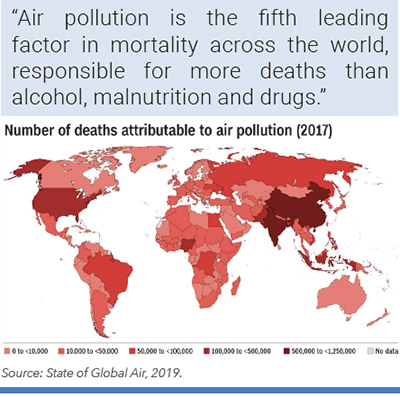 Also in April, a study by Terry Hughes and colleagues published in the journal Nature generated media attention. This study found that climate change has been thwarting coral growth at the Great Barrier Reef. These findings garnered stories across media outlets such as The Guardian, BBC, USA Today, and The New York Times. For example, journalist Doyle Rice at USA Today wrote, “Coral in Australia's iconic Great Barrier Reef just can't handle the heat. In fact, as global warming heats the reef, the coral there isn't able to recover”. And a study of glacial melt also published in the journal Nature led to considerable media attention. This study found that glacial melt contributed to 1 inch of sea level rise over the past 50 years. For example, Nina Avramova from CNN reported, “Most glaciers in Central Europe, Western Canada and the United States would vanish in the second half of this century under the current rates of ice loss, according to a new report. Glaciers have lost over 9,000 billion tons of ice between 1961 and 2016, according to a research letter published in the journal Nature on Monday. This amounts to a block of ice the size of Germany and almost 100 feet thick, or the size of the United States and 4 feet thick ...”. Meanwhile, journalist Seth Borenstein from the Associated Press wrote, “Earth’s glaciers are melting much faster than scientists thought. A new study shows they are losing 369 billion tons of snow and ice each year, more than half of that in North America. The most comprehensive measurement of glaciers worldwide found that thousands of inland masses of snow compressed into ice are shrinking 18 percent faster than an international panel of scientists calculated in 2013”.
Also in April, a study by Terry Hughes and colleagues published in the journal Nature generated media attention. This study found that climate change has been thwarting coral growth at the Great Barrier Reef. These findings garnered stories across media outlets such as The Guardian, BBC, USA Today, and The New York Times. For example, journalist Doyle Rice at USA Today wrote, “Coral in Australia's iconic Great Barrier Reef just can't handle the heat. In fact, as global warming heats the reef, the coral there isn't able to recover”. And a study of glacial melt also published in the journal Nature led to considerable media attention. This study found that glacial melt contributed to 1 inch of sea level rise over the past 50 years. For example, Nina Avramova from CNN reported, “Most glaciers in Central Europe, Western Canada and the United States would vanish in the second half of this century under the current rates of ice loss, according to a new report. Glaciers have lost over 9,000 billion tons of ice between 1961 and 2016, according to a research letter published in the journal Nature on Monday. This amounts to a block of ice the size of Germany and almost 100 feet thick, or the size of the United States and 4 feet thick ...”. Meanwhile, journalist Seth Borenstein from the Associated Press wrote, “Earth’s glaciers are melting much faster than scientists thought. A new study shows they are losing 369 billion tons of snow and ice each year, more than half of that in North America. The most comprehensive measurement of glaciers worldwide found that thousands of inland masses of snow compressed into ice are shrinking 18 percent faster than an international panel of scientists calculated in 2013”.
Last in April, media covered ecological and meteorological connections with climate issues. For example, cyclone Kenneth making landfall in Mozambique drew media attention, along with numerous discussions of links to climate change. Reports from CNN, The New York Times, The Washington Post, and BBC dotted the landscape of coverage exploring connections between the disasters associated with cyclone Kenneth (and Cyclone Idai in the previous month), yet connections are more often considered than definitively linked. For example, in an Associated Press article, journalist Frank Jordans observes, “experts caution it is premature to say whether the unprecedented double-whammy of storms to hit the southern African nation is a consequence of climate change, and whether these cyclones will become more common”.
Going forward, MeCCO continues to monitor and analyze these stories as they unfold.
